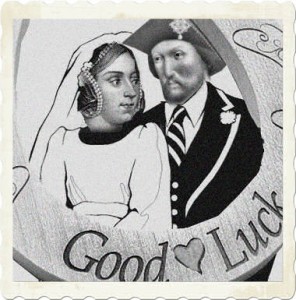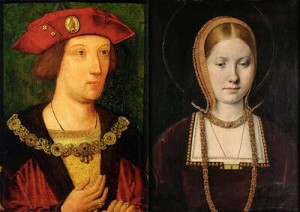 Henry VIII and Anne Boleyn returned from their trip to Calais on St Erkenwald’s Day (14th November) 1532, landing at Dover, on the Kent coast, at 5am.1 The couple then took their time travelling to London. Eustace Chapuys, the Imperial ambassador, wrote that the King spent a few days in Dover and the surrounding area “for the purpose of having harbours constructed in the said town, or at least of creating a spacious plea for asking money from his subjects for the said works”, and that he did not arrive at Eltham Palace until 24th November.2 However, chronicler Edward Hall gives another reason for the couple’s slow progress: they got married!
Henry VIII and Anne Boleyn returned from their trip to Calais on St Erkenwald’s Day (14th November) 1532, landing at Dover, on the Kent coast, at 5am.1 The couple then took their time travelling to London. Eustace Chapuys, the Imperial ambassador, wrote that the King spent a few days in Dover and the surrounding area “for the purpose of having harbours constructed in the said town, or at least of creating a spacious plea for asking money from his subjects for the said works”, and that he did not arrive at Eltham Palace until 24th November.2 However, chronicler Edward Hall gives another reason for the couple’s slow progress: they got married!
Hall records:
“The kyng after his returne, maried priuily the lady Anne Bulleyn, on sainct Erkenwaldes daie, whiche mariage was kept so secrete, that very fewe knewe it, til she was greate with child, at Easter after.”3
So, perhaps the couple were simply enjoying being man and wife before returning to court, and reality, in London.
Hall is the only contemporary source to record this secret wedding, but I, for one, put some store in his record. After years of waiting to consummate their marriage, the couple suddenly began co-habiting after this visit to France and Anne became pregnant with Elizabeth before the couple’s secret marriage ceremony on 25th January 1533. I feel that this suggests that the couple made some kind of formal commitment to each other. What do you think?
14 November 1501 – Marriage of Arthur, Prince of Wales, and Catherine of Aragon
 On 14th November 1501, Catherine of Aragon married Arthur, Prince of Wales at St Paul’s Cathedral. Giles Tremlett,3 author of Catherine of Aragon: Henry’s Spanish Queen, writes of how a huge wooden stage, measuring twelve feet by 350 feet, had been erected in the cathedral. It stood on four foot struts and its railings were decorated with “say”, a fine wool or silk twill cloth. The stone walls of the cathedral were covered with tapestries and there was a red carpeted raised circular dais. It must have looked amazing.
On 14th November 1501, Catherine of Aragon married Arthur, Prince of Wales at St Paul’s Cathedral. Giles Tremlett,3 author of Catherine of Aragon: Henry’s Spanish Queen, writes of how a huge wooden stage, measuring twelve feet by 350 feet, had been erected in the cathedral. It stood on four foot struts and its railings were decorated with “say”, a fine wool or silk twill cloth. The stone walls of the cathedral were covered with tapestries and there was a red carpeted raised circular dais. It must have looked amazing.
Catherine, dressed in a white satin wedding dress was escorted from the Bishop’s Palace to the cathedral door by the ten year old Prince Henry, who would later become her second husband, and Lady Cecily of York carried her train. Catherine’s dress was Spanish in style with a farthingale and “many pleats” and her face was covered with a white silk veil decorated with a border of gold, pearls and gemstones. Her bridegroom, Prince Arthur, was also dressed in white satin.
Tremlett describes how the beginning of the wedding ceremony “was about politics and money”, with the marriage agreements being read out and Catherine’s dowry being announced. The bride was also given letters patent detailing her endowment and surety. After that, it was time for the religious part of the ceremony: the vows and mass. Catherine was then escorted out of the cathedral, to the sound of trumpets, by the young Henry while Arthur got himself ready to welcome her at the door of her chamber.
While the people of London enjoyed a pageant with a fountain running with wine, Catherine and Arthur enjoyed a sumptuous wedding banquet. Tremlett writes of how this was only the start of the celebrations and that the partying went on for a fortnight, consisting of jousts, masques and banquets.
After the feasting, it was, of course, time for the wedding night, the consummation of their marriage. The question of whether this marriage was ever actually consummated is still debated today. When Henry VIII was trying to annul his marriage to Catherine in the late 1520 and early 1530s, Catherine vowed that she had never slept with Arthur and this is backed up by evidence heard in Zaragoza, Spain, in 1531. There, Juan de Gamarra, who had been a boy in Catherine’s service at the time of her wedding, told of how the Prince had got up early the morning after and that when he, Gamarra, had entered Catherine’s rooms her ladies were concerned for Catherine and disappointed with the Prince. Gamarra stated:-
“Francisca de Cáceres, who was in charge of dressing and undressing the queen and whom she liked and confided in a lot, was looking sad and telling the other ladies that nothing had passed between Prince Arthur and his wife, which surprised everyone and made them laugh at him.”4
English witnesses, however, tell of Arthur demanding ale the next morning “for I have been this night in the midst of Spain!”
We just don’t know for sure what happened that night and during their short marriage.
Also on this day in history…
- 1541 – An inventory was taken “of the goods and chattels, lands and fees of Thos. Culpeper, the younger”, the alleged lover of Queen Catherine Howard. The list included two caps of velvet given to him by the King, swords, daggers, clothing, furniture, revenues from his lands (including “the manors of Zanworth, Haselton, Nawnton and Enford, with the parsonage, Glouc. and Wilts, Fordam and Argentynes, Essex, the late monastery of Comwell, Kent”), offices he held (“Clerk of the Armoury, keeper of the house and parks of Penshurst and North Lye, master of the game and steward of the lordships of Southfryth and Northfrith, lieutenant, &c., of Tonbryge castle, keeper of Posterne and Cage parks, steward, &c., of Ashdowne forest”), horses and harness, and hangings. You can read the full inventory at www.british-history.ac.uk, it’s note 1343. (LP xvi, 1343)
An inventory of Jane Boleyn, Lady Rochford’s possessions had already been taken:
“List of plate (7 items), apparel (11 items, one “a little steel casket with a purse and forty pounds in it”), and jewels (8 items, viz., “a broach with an ag[ate], a cross of diamo[nds] with three pearls pendant, a flower of rubies, a flower with a ruby and a great emerald with a pearl pen[dent], a tablet of gold with black, green, and white enamelled, a pair of bracelets of red cornelyns, a pair of beads of gold and stones, a broach of gold with an antique head and a white face.”” (LP xvi. 1340)
Notes and Sources
- Hall’s Chronicle, Edward Hall, p794
- Calendar of State Papers, Spain, 1531-1533, p556-557
- Hall’s Chronicle, p794
- Catherine of Aragon: Henry’s Spanish Queen, Giles Tremlett (2010), p86
- Ibid., p89
- LP xvi. 1340, 1343